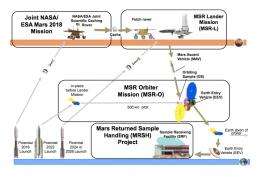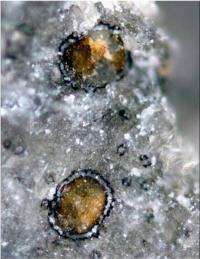Bringing Mars back to Earth

The search for life should be an essential component of a sample return mission from Mars, according to a recent report examining the science behind such a venture.
A team of scientists, including technical advisors from NASA and the European Space Agency, and scientists from the United States, Canada, and Europe, identified and prioritized four scientific objectives involved with bringing material from the red planet back to Earth. The search for life, past and present, topped the list, while the preparation for human exploration came near the bottom of the list.
"The decadal survey and others have pretty much concluded that the next logical step is sample return," said Scott McLennan, of Stony Brook University in New York.
McLennan, who was part of the international team, was confident that a mission exploring the top four concerns listed in the report could be planned given the information known about Mars.
"There're good reasons to believe we can identify a place where we would get back the samples that would address the high-priority questions."
The search for science
After examining previous scientific objectives, and incorporating recent perspectives from the Mars science community, the international team proposed four aims to a future sample return mission, with the hopes of providing a guide for future campaigns.
The search for signs of life ranked at the top of the list. While looking for living organisms on Mars would be akin to searching for a needle in a haystack, the team felt that current research could help target areas likely to have been hospitable to life in the past.
"Most people think that the conditions under which life might have initially evolved would be different from the conditions on the present day surface of Mars," McLennan said.
"Mars right now would be a pretty tough place to live."
While most of Mars resembles a dry, dusty wasteland, scientists think the surface of the planet once boasted liquid water, considered the best ingredient for the formation of life. As on Earth, such life could have existed in a wide variety of environments.
"If we can find the kinds of rocks that reflect those environments - and we think we can, with some confidence - then that strikes us as the place to look."
But make no mistake - though searching for life on Mars today might be a challenge, all samples returned would be examined for evidence of its existence.
Next on the list of objectives is an increase in knowledge about the martian surface. Knowing where water may have flowed should clarify past habitability, while examining the surface also could reveal the climate changes that cost Mars its atmosphere.

The third objective is to better understand how the planet has evolved over time. By studying both old and young volcanic rocks, scientists hope to obtain a better understanding of the geologic history of Mars. Similarly, these rocks could provide clues about how the Martian magnetic field has changed over time. As part of understanding how the red planet has changed, the team also hopes to gather a sample of its atmosphere, enabling them to better understand how it has diminished over time.
Preparing for a manned mission to Mars falls near the end of the list. Still, bringing home pieces of the planet could help scientists locate potential resources on Mars that could be used to return astronauts to Earth, as well as identify possible hazards that explorers might encounter while interacting with the top layer of the planet.

"Before we have a manned mission to Mars, we need to have a sample return," said Janice Bishop, a planetary scientist who studies Mars at the SETI Institute.
Along with a better understanding of the planet, she points out that such a mission also would provide a test run for going to Mars and coming back to Earth, something that the current one-way missions to Mars just don't do.
"To send a mission that's returning to Earth is much harder," she said.
Three launches, one mission
To complete a sample return mission, the group concluded that at least three trips to Mars would be required.
The first would launch a sample-collecting rover. The team recommended the rover be capable of collecting at least 30 rocks. Ideally the rover would gather samples from a number of different Martian environments, some with duplicates to provide better context. Weighing in at about 15 grams each, the samples would be large enough to answer a variety of questions,.
The team also stressed the importance of being able to switch out samples if a better opportunity came along. Being able to select the best choices from a bag of rocks that were already collected should eliminate that concern.
"For Mars, we probably won't have the luxury of multiple sample return missions as on the Moon," Bishop said.
"Which samples you actually grab to bring back is essential."
The second launch would put an orbiter around Mars, which would provide the necessary communications for the arrival of the third mission, a lander with a "fetch rover" that would pick up the samples the first rover had collected, the samples themselves lasting indefinitely. The orbiter would then be responsible for bringing the samples back to Earth.
The team stressed that the missions need not take place back to back; the first, sample collecting rover could explore Mars for many years before a pickup was arranged. Thus a commitment to one mission did not necessarily require an immediate commitment to all three.
A closer look
Over the past fifteen years, NASA has sent three orbiters, a lander and three rovers to Mars, and has worked with ESA on another orbiter. Mars Science Laboratory (MSL), with its rover, Curiosity, is set to reach the planet this summer.
"The ability to do remote work has gotten better and better, and in some ways, it's just staggering," McLennan said.
MSL, for instance, "is going to take samples, grind them up, and put them into a real, honest-to-goodness analytical lab that we would be happy with on Earth."
Yet there are some things that we simply cannot do on the surface of Mars, either because the necessary instruments can't be transported, or because the samples require impossible manipulations.
In Mars missions, discoveries often lead to new, unanticipated questions. For remote analysis, you're simply stuck with the instruments that you’d sent to Mars. However, samples of Mars that are brought back to Earth can be studied in ways not originally considered in the mission planning.
"When you bring a sample back, you can continually re-ask questions," McLennan said.
Both McLennan and Bishop stress the benefits of international co-operation. The most obvious is sharing the cost.
"Most countries are having a difficult time funding large missions on their own," Bishop said.
Provided by Astrobio.net





















